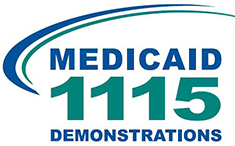Medicaid Managed Long-Term Services and Supports: Summative Evaluation Report
New Approaches for Medicaid: The 1115 Demonstration Evaluation
Prepared for:
U.S. Department of Health and Human Services, Centers for Medicare & Medicaid Services, Center for Medicaid and CHIP Services
- We found more favorable responses for managed long-term services and supports (MLTSS) enrollees compared to fee-for-service (FFS) beneficiaries for survey items related to self-reported access, experience, and quality of life.
- For other outcomes we examined, the findings of our evaluation do not demonstrate conclusively that MLTSS has clear benefits over FFS delivery systems in all states and for all long-term services and supports (LTSS) populations. In some states, for some years, and for certain groups of LTSS beneficiaries, there is greater use of home and community-based services, lower use of nursing homes, and fewer hospital days and potentially avoidable hospitalizations, but the results are inconsistent.
- Several improvements in data are needed to provide more conclusive evidence on the effects of MLTSS.
To evaluate how managed long-term services and supports (MLTSS) beneficiaries compare to those receiving long-term services and supports (LTSS) in fee-for-service (FFS), we addressed five research questions focused on spending, service use, quality of care, access to care, and beneficiary experience and quality of life outcomes. For spending, we used 2017 expenditure data to examine the breakdown of MLTSS spending by different categories of service. For service use and quality of care, we used Medicaid administrative data from 2014 to 2017 to evaluate MLTSS programs in Florida, Kansas, and Tennessee. We implemented a repeated cross-sectional design with matched comparison groups at the MLTSS program-level to evaluate ten service use and quality of care outcomes related to nursing facility use, home and community-based service (HCBS) use, and hospitalizations, separately for dually eligible and Medicaid-only enrollees. For access to care and beneficiary experience and quality of life, we used beneficiary-reported data from 33 items from the 2016 to 2018 National Core Indicators-Aging and Disabilities (NCI-AD) survey pooling data from seven states with MLTSS programs and 14 states covering similar LTSS on a FFS basis. We found that MLTSS programs spent a greater portion of their total MLTSS expenditures on HCBS than institutional care (68.9 and 56.3 percent, respectively), although there is significant variation across states. We found mixed results across programs and populations for all measures of service use and quality of care, but more favorable responses among MLTSS enrollees for survey questions related to access to care and beneficiary experience and quality of life. Several improvements in data are needed to construct a comparable set of measures and outcomes across states for beneficiaries with the same characteristics to provide more conclusive evidence of the effects of MLTSS relative to FFS. Future evaluation work at the state or federal levels depends upon continued progress to address important data gaps.
How do you apply evidence?
Take our quick four-question survey to help us curate evidence and insights that serve you.
Take our survey
